One of our main aims is the study of many-particle (cooperative) effects in kinetics of bimolecular reactions in condensed matter, including radiation defects. Most of this research is based on a novel formalism of many-particle densities described in our book [E.A. Kotomin and V.N. Kuzovkov, "Modern aspects of diffusion-controlled reactions" (Amsterdam: Elsevier, 1996)].
Surface-induced reactions are known to play a very important role in heterogeneous catalysis. We study these reactions with emphasis on such fundamental phenomena as pattern formation, reactant self-organisation, regular and irregular reactant concentration oscillations as well as chaotical behavour in the case of simple reactions on low-index crystalline surfaces. Another two activities deal with the growth mode of thin metallic films on oxides and diffusion in ceramics, composites and heterogeneous media which is of great importance for the interpretation of experimental data.
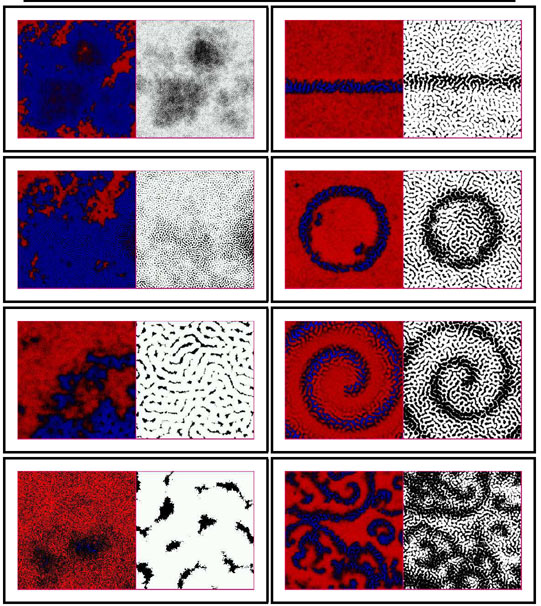
We use methods of parallel computer simulations in first-principles (ab initio), molecular dynamics, as well as empirical, shell modelling of numerous prospective technological materials used, e.g. in cathodes of solid oxide fuel cells and lithium batteries. For advanced perovskites and ferroelectrics, we mainly simulate defect-induced and surface-induced processes.
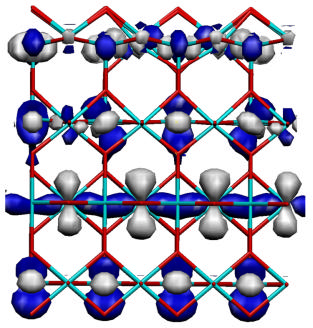
In our theoretical studies (closely cooperated with experimental groups) we combine fundamental research (the Anderson localization) with very applied and technologically important problems (new nanomaterials).
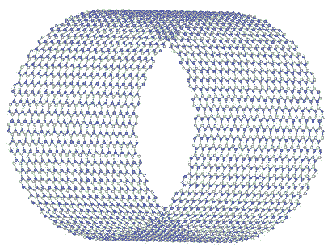
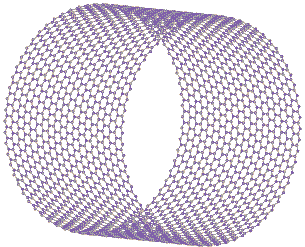
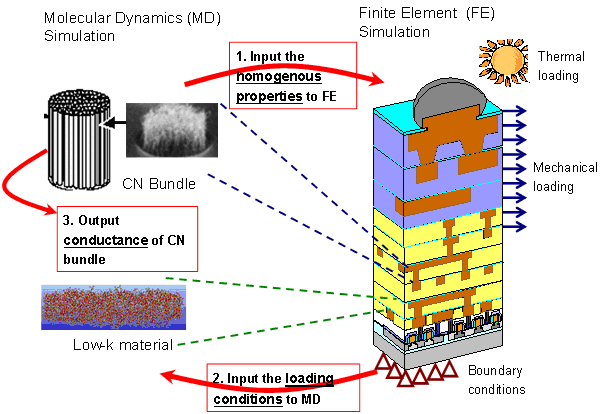
Scheme of the multiscale simulation of CNT-interconnected IC backend structure
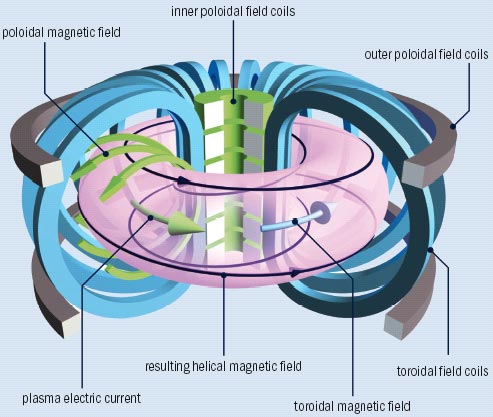
We combine several different techniques, including analytical formalisms and large-scale computer simulations (quantum chemical methods, molecular dynamics, stochastic simulations as well as Monte Carlo/cellular automata modeling). See more Equipment and Latvian Super Cluster Homepage
Our current activities cover
Our laboratory research is supported by:
1. EUROATOM-Latvia Fusion Project (in close collaboration with Germany, Greece, Finland and Romania),
2. EC Framework 7 project CATHERINE (Carbon nAnotube Technology for High-speed nExt-geneRation nanoInterconNEcts; in close collaboration with Italy, France, Netherlands, Sweden and Romania),
3. EC Framework 7 project on Advanced Nuclear Fuels F-Bridge (Basic Research for Innovative Fuel Design for GEneration IV systems; in close collaboration with France, Germany, and Czech Republic)
4. Euratom Actinet networking project,
5. Latvian Materials Science Programme,
6. Latvian National Programme on Energetics,
7. Functional Materials and Technologies for Microelectronics and Photonics (Project No 05.0005.1.1),
8. European Social Fund.
Former grants:
1. Nanomaterials and Nanotechnologies (Project No 05.0026.1.1),
2. Polar Dielectrics: Application - Grade Simulation and Optimization (Project No 05.1704),
Awards:
F.Cander medal of Latvian Academy of Sciences (E. Kotomin, 1997),
Humboldt Followships (V.Kuzovkov, 1988, S. Piskunov 2006).
Recent PhD Theses:
G. Zvejnieks (2001, Osnabrueck University, Germany)
S. Piskunov (2003, Osnabrueck University, Germany)
V.Kashcheyevs (2006, Tel-Aviv University, Israel)
D.Gryaznov (2006, Max Planck Institute, Stuttgart)
- Sickafus K. and Kotomin E.A. (eds.) Radiation Effects in Solids. - NATO ASI Science series II, Physics, Chemistry, Mathematics, 2006, vol. 235, Amsterdam, Berlin, Oxford, 560 p.
- Catlow C.R.A. and Kotomin E.A. (eds.) Computational Materials Science.- NATO Science series III. Computer and System Sciences, 2003, vol. 187, Amsterdam, Berlin, Oxford.
- Kotomin E.A. and Kuzovkov V.N., Modern Aspects of Diffusion-Controlled Processes: Cooperative Phenomena in Bimolecular Reactions. - Amsterdam: Elsevier (Vol. 34 in a series of Comprehensive Chemical Kinetics), 1996, 612 p.
- Kantorovich L.N., Kotomin E.A., Kuzovkov V.N., Shluger A.L., Tale I.A., and Zakis Yu.R., Models of defect processes in wide-gap solids (Russ). - Riga: Zinatne, 1991, 382 p.
- Evarestov R.A., Kotomin E.A., and Ermoshkin A.N., Molecular models of point defects in wide-gap solids (Russ). - Riga: Zinatne, 1983. 287 p.
- Rolov B.N., Ivin V.A., and Kuzovkov V.N., Statistics and kinetics of phase transitions in solid state (Russ). - Riga: Zinatne, 1979, 179 p.
- Yu.F. Zhukovskii, E.A. Kotomin, R.A. Evarestov, and D.E. Ellis, Periodic models in quantum chemical simulations of F centers in crystalline metal oxides. - Intern. J. Quant. Chem., 2007, 107, p. 2956-2985.
- E.A. Kotomin and A.I. Popov, The kinetics of radiation-induced point defect aggregation and metallic colloid formation in ionic solids. In: Radiation Effects in Solids (NATO ASI Science Series II. Physics, Chemistry and Mathematics, Vol. 235), Amsterdam, Berlin, Oxford, 2006, p. 153-192.
- E.A. Kotomin, R.I. Eglitis, G. Borstel, and P.W.M. Jacobs, Modelling of point defects, polarons and exitons in ferroelectric perovskites. In: Computational Materials Science (NATO Science series III. Computer and System Sciences, Vol. 187), Amsterdam, Berlin, Oxford, 2003, p. 291-307.
- E.A. Kotomin, E. Heifets, P.W.M. Jacobs, G. Borstel, W.A. Goddard Theoretical simulations of surface relaxation for perovskite titanates. - In: Proc. NATO ARW on Defects and Surface - Induced Effects in Advanced Perovskites, Riga, August 1999 (Kluwer 2000), p. 209-220.
- V.N. Kuzovkov, Aggregation and Structure Formation in Reaction-Diffusion Processes in Chemical Systems. - In: Aggregation phenomena in complex systems (Chapter Nr 8), Eds. J. Schmelzer, G. Röpke, R. Mahnke (Weinheim: Wiley-VCH, 1999), p. 205-239.
- E.A. Kotomin and A.I. Popov Radiation-Induced Point Defects in Simple Oxides. - Proc. Int. Conference on Radiation Effects in Insulators (REI-9), Nuclear Instruments and Methods, 1998, B 141, p.1-15.
- E.A. Kotomin and V.N. Kuzovkov, Phenomenological Theory of the Recombination and Accumulation Kinetics of Radiation Defects in Ionic Solids. - Rept. Progr. Phys., 1992, 55, p. 2079-2202.
- V.L. Vinetsky, Yu.R. Kalnin, E.A. Kotomin, and A.A. Ovchinnikov, Radiation-induced Frenkel Defect Aggregation in Solids. - Sov. Phys.-Uspekhi, 1990, 33, p.793-811.
- V.N. Kuzovkov and E.A. Kotomin, Kinetics of Bimolecular Reactions in Condensed Media. - Rept. Progr. Phys., 1988, 51, p. 1479-1524.
- A.B. Doktorov and E.A. Kotomin Theory of Tunnelling Recombination of Defects Stimulated by Their Motion. (I). General formalism. - Phys. Stat. Solidi (b), 1982, 114, p. 9-14.
- E.A. Kotomin and A.V. Doktorov Theory of Tunnelling Recombination of Defects Stimulated by Their Motion. (II). Three Recombination Mechanisms. - Phys. Stat. Solidi (b), 1982, 114, p. 287-318.
See also publications
Last Updated: March 14, 2008


